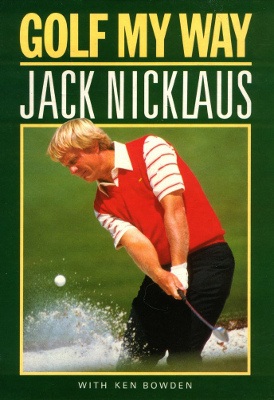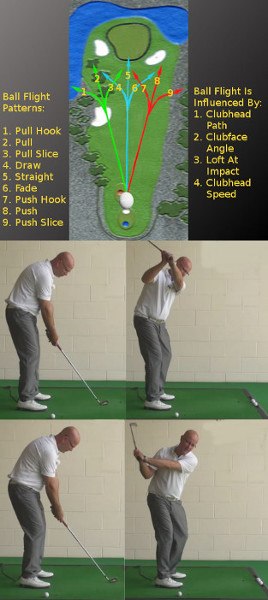
First published in 1974, Golf My Way by Jack Nicklaus wasn't a technical tour de force like Ben Hogan's Five Lessons: The Modern Fundamentals of Golf nor a fount of homespun practical wisdom like Harvey Penick's Little Red Book. But Nicklaus' contribution to golf literature may have impacted the game more than any other instruction guide.
Nicklaus was in his prime when Golf My Way hit the shelves, so it's no surprise the book has sold more than 2 million copies worldwide and never gone out of print. In fact, it's now available on DVD, and there's even a Golf My Way iPhone app. The original book (and later versions) features hundreds of succinct, easy-to-follow lessons on everything from equipment to the setup to the finish, with helpful illustrations by Jim McQueen that greatly aid the reader's understanding.
Clearly, Nicklaus and his long-time collaborator Ken Bowden got something right. Many famous pros have cited Golf My Way as their introduction to the golf swing: Greg Norman, Ernie Els, Ian Baker-Finch and K.J. Choi to name a select handful. In fact, many credit the book with inspiring them to play the game seriously in the first place.
It makes sense that so many golfers, both new and experienced, would seek to emulate Nicklaus. His record is considered the greatest in golf, topped by 18 professional major championships. And it wasn't just what he won that made Nicklaus' methods so appealing, but how he won.
The “Golden Bear” could overpower courses with prodigious length, yet he's regarded as one of golf's master strategists. He launched towering long irons like no one before him, wowing fans with shots like his laser 1-iron on the 71st hole of the 1972 U.S. Open. Nicklaus putted brilliantly too – especially in pressure-packed moments.
The irony behind Golf My Way is that Nicklaus' swing was far from “textbook.”

His so-called “flying right elbow” strayed noticeably away from his side at the top of the backswing, a rarity among top pros. His swing plane was markedly upright (vertical) as well, a major departure from the flatter arc employed by Hogan and other stars. Plus, Nicklaus never developed a short game to match rivals like Gary Player, Lee Trevino and Tom Watson.
Of course, Golf My Way didn't teach golfers to copy Nicklaus' quirks or ignore their chipping and bunker play. The book did exactly what its title promised: It explained how the world's greatest player approached every aspect of golf, in a language the Average Joe could easily transfer to his own game.
Add that to Nicklaus' list of major victories.
Learn the unique address positions Nicklaus employed to enhance his power and ballstriking.

Jack Nicklaus Golf My Way Inspired Millions of Players
For many golfers, the argument of who is the best player in the history of the game begins and ends with Jack Nicklaus. While Tiger Woods would get plenty of support in this debate as well – and deservedly so – it is hard to argue with Nicklaus' raw statistics. The winner of a whopping 18 major championship titles, Nicklaus also finished either second or third in those events a total of 28 times. He won 73 times on the PGA Tour, was inducted into the World Golf Hall of Fame, and was the PGA Tour Player of the Year five times. Any way you look at it, Nicklaus stands apart from the field.
With a career as legendary as this one, it is no surprise that Jack Nicklaus decided to write a book in order to publish his thoughts and opinions on how the game is to be played. Initially put into print in 1974, Golf My Way is a classic in the world of golf instruction. Any serious golf teacher has read this book, and many keep it on a shelf close at hand. It is hard to say exactly how many golfers were impacted by reading Golf My Way, but that number is certainly a big one.
Not only did Nicklaus have this book published four decades ago, but he has also kept it relevant to the modern game with updates – the latest coming in 2005. There is no doubt that golf has changed dramatically in the time since Nicklaus first wrote the book along with Ken Bowden, but many of the lessons contained in this classic are time-honored and will help golfers today just as they helped golfers so many years ago.
In this article, we are going to look at some of the key points highlighted by Nicklaus in this book. Of course, we would highly recommend that you go ahead and purchase the book for yourself in order to get the full effect of his instruction. This article will not rehash his instruction so much as touch on some of the key points and offer our own perspective on those areas of the game. We hope that we are able to provide some tips which will benefit you on the course, and we also hope that you will take time to read Mr. Nicklaus' book in the near future.
All of the content below is written from the perspective of a right-handed golfer. If you happen to play left-handed, please take a moment to reverse the directions as necessary.

Find Your Own Game
One of the lasting lessons that all golfers should take away from this book is the concept that you should be trying to find your own game – rather than copying the game of another player. It would have been easy for Nicklaus to simply say 'swing like I do', but he knew that would not be good advice. It is difficult to copy the swing technique of another player, and that is certainly true when the player in question is perhaps the greatest of all time.
Instead of trying to imitate your favorite player on the links, you should be trying to be the best version of yourself. To make sure you are remaining focused on your own strengths rather than trying to imitate someone else, keep the following points in mind.
- Build on your natural motion. Often, golfers will decide that they are going to 'start over' with their swings, building a motion from the ground up. It is easy to talk yourself into this idea, but it is a mistake. Rather than trying to start over from scratch, you should always be working on improving the swing that comes to you naturally. You can make changes as you go, of course, as you aren't going to get better unless you are able to refine your technique one piece at a time. However, trying to reset the whole thing and build it up again based on someone else's swing is only going to lead to frustration. The best way to consistently move forward in golf is to take one small step at a time, growing from day to day as you become the best version of yourself. Jack Nicklaus became the greatest golfer in the world by being true to himself and constantly working toward improvement. You might not be headed for those heights, but you can make progress simply by avoiding the temptation to build something that is not true to your game.
- Don't accept too much help. It is a great idea to work with a golf pro on your game. An experienced pro will be able to offer plenty of great tips, and he or she will be able to get to know your game over a period of several lessons. However, you should not be as willing to take help from random people on the golf course, including other players in your group. Some golfers love to offer up tips on everything from your swing to your putting stroke – even if they aren't really qualified to give this kind of advice. Do your best to tune out the ideas of other players unless you are sure that they know their stuff. Advice in the game of golf is best received in the form of a formal lesson, or through written material such as Jack Nicklaus' book.
- Be proud of your game. Some golfers feel insecure on the course because they are not able to play quite as well as others at the club. These feelings of insecurity are only going to stand in your way. Do your best to have pride in your game and take ownership of your swing. No one has a perfect golf swing, so there is no need to be embarrassed by your game or anything like that. You can know that you need to work on your swing while still being proud of the game that you have built so far.
If you try to build your game by copying anyone else, you are never going to have true ownership of that game. In essence, you will always be just using a copy of what someone else has built – and that means it will never work as well as something which is completely yours.
You can be sure that the swing Jack Nicklaus used throughout his career was truly his own. Was it perfect? No – despite being the best in the world, Nicklaus hit bad shots from time to time, just like anyone else. However, the occasional poor swing didn't cause Nicklaus to move away from his own natural motion. He trusted it, he knew it could get the job done, and he rode that swing all the way to the record books.
Your biggest challenge on this point is to commit to building up your own swing despite any current struggles you are having on the links. Even if you aren't particularly happy with your game at the moment, and even if you feel like your swing needs to get a lot better, don't fall into the trap of trying to copy someone else's technique. Take a careful look at your swing, identify what it is that needs to be improved, and get down to work one piece at a time.

Create a Go-To Ball Flight
Was Jack Nicklaus capable of producing a variety of ball flights on command? Of course he was. You don't rise to the top of the golf world without the ability to match your shots to the demands of the course. With that said, Nicklaus achieved much of his success thanks to one specific shot – the fade. Golf fans around the world remember many of the beautiful left-to-right shots that Nicklaus was able to produce under pressure. Nicklaus was so good with the fade that you can even see signs of his preference for a left-to-right shot in many of the courses that he has designed around the world.
The point here is not that you need to copy Nicklaus' fade to the best of your ability. Rather, the point is that you need to develop a reliable ball flight of your own. If you have a shot that you can lean on time after time for dependable results, your game will naturally improve. The following list highlights of few of the benefits of having a go-to ball flight.
- Confidence. As you know, there is nothing quite like the power of confidence in golf. When you feel confident, your targets look big and you feel like you can do anything. On the other hand, if you are unsure of yourself, it is the hazards which look big as you think about all the bad places the ball may end up. With a reliable ball flight on your side, you will always have a shot you can turn to when things get tough. Playing a particularly difficult hole, or going through a rough stretch in your round? Use your go-to ball flight and feel good as you make your swing. There will be a time and a place for creating other ball flights, but you always want to lean on your stock shot when the game gets tough.
- Simplicity. Golf can get a little complicated while you are in the middle of a round. There are a lot of decisions to be made, from club selection choices to target lines and more. When you can find a little bit of simplicity along the way, you should take it. By using your go-to ball flight a majority of the time, you will be able to take one step out of your decision-making process. Unless you are in a spot which is obviously going to call for another type of shot, you can just assume you will use your go-to shot and move on to other choices. Streamlining your decision-making work by taking one step away will help you relax and focus more intently on playing your best.
- Performance under pressure. This is one of the best things about having a go-to ball flight in your bag. When you start to feel pressure on the course – maybe because you are getting toward the end of a round and you have a good score going – you can lean on this trusted ball flight to get you to the house. You always want to have as much confidence as possible on your side when the nerves kick in. Since you know you can trust this ball flight, the doubts that usually come into the back of your mind while playing pressure golf will be kept at bay. It is easy to see how the reliability of his left-to-right shot would have helped Nicklaus during the many pressure situations he encountered throughout his career.
It is a great feeling to know that you have a reliable ball flight waiting and ready to go at any time. It would be an exaggeration to say that this makes the game 'easy', as nothing can make golf easy. You will find the game to be a bit easier, however, and you will probably find it to be more enjoyable as well. Work on solidifying one ball flight that you can use as your go-to shape for most situations and your game is sure to improve.

The Value of Tempo
One of the points Nicklaus makes in this classic book is highlighting the importance of tempo. It probably isn't breaking news to you that tempo is important in golf, but reading it from one of the all-time greats is certainly nice confirmation. If you hope to raise the level of your own play in the years to come, focusing on your tempo would be a great place to start.
Of course, working on your tempo is not the same as copying the tempo of another golfer. As we have already made clear, you should not be trying to copy the game of another player. So, when working on tempo, you don't want to just watch a video of Jack Nicklaus and then do your best to replicate what you see. Rather, you are going to be trying to find your own smooth tempo, one swing at a time. You have a great tempo hiding somewhere in there – you just need to find it.
So how do you know when you have unlocked the perfect tempo for your own game? The results you achieve will show you the truth. If you are starting to hit the ball more consistently and more powerfully than ever before, your tempo must be in good shape. To give yourself the best possible chance of finding that tempo, consider these tips.
- Never be in a rush. Without a doubt, rushing is the number one cause of poor tempo in golf. Very few amateur golfers have a problem with swinging too slowly. It is extremely common for amateur golfers to rush through the swinging action, whether they just want to get it over with or they are anxious to see where the ball goes. Whatever the case, rushing is only going to lead to trouble. To swing with a beautiful tempo that is all your own, put aside any thoughts of rushing through the golf swing. Take a deep breath before you walk up to the ball, realize that you have plenty of time to make your swing, and only begin when you are ready. As long as you give your swing all the time it needs to play out naturally, you should be on the right track.
- Always slow at the top. Some golfers play best with a slow tempo, while others play at their highest level when they move quickly through most of the swing. Neither one is right or wrong, but both groups need to take enough time at the top to transition properly into the downswing. If you rush through the transition, it won't really matter what you do during the rest of your swing – you will be in trouble. Take your time to shift from backswing to downswing by using your lower body to initiate a movement toward the target.
- Try a variety of options. On the range, you can intentionally use various slow and fast tempos until you figure out what works best for you. Hit a few driver shots while going back and forth between a quick pace and a slow one. Which feels more comfortable, and which yields the best results? It shouldn't take much time at all to figure out which type of tempo is the best fit for your personality and your game.
It is nearly impossible to reach your potential on the golf course without gaining a solid understanding of your tempo. Sure, you can make progress by putting all of your body parts in the right positions during the swing, but that will only take you so far. From there, you need to have a smooth tempo to bring everything together just right.

Constant Evolution
One of the most interesting points which is made by Mr. Nicklaus in his book has to do with the way an individual's golf game will change from day to day or week to week. He talks about how he was always finding new swing thoughts or feelings to navigate his way around the course. And he was the best golfer in the world! If you are thinking that your game is ever going to be stable from round to round, you are lying to yourself. This is a hard game, and you are always going to need to adapt on the fly in order to play your best.
The first thing you can do with regard to this point is to accept the fact that things will always be changing. If you get frustrated because you constantly are looking for new answers, you might think that something is wrong with your game. Don't think this way. It is perfectly normal for all golfers to be in a constant state of flux, so accept that for what it is and move on. You are not alone – this game is difficult for everyone who picks up a club, even the great Jack Nicklaus.
Another thing you can learn from this thought is that you need to always pay attention to the changing state of your game. Don't just walk out to the first tee assuming your game will be the same as it was yesterday – rarely will that be the case. Instead, you should always expect that you will need to find new ways to get the job done. That doesn't mean making dramatic changes to your technique from round to round, but it does mean being open to subtle tweaks. Pay close attention to each shot that you hit and respond quickly to any problems that may be popping up.
If you find that it is difficult to adjust your game on the fly, it may be helpful to keep a list of swing thoughts in your bag for quick reference. Often, you will find something that works during one round, only to completely forget it by the time you play again. This is frustrating, to say the least. Instead of getting stuck in that pattern, make some notes and tuck them away in your bag. Then, when you are in the middle of a round that is not going quite to plan, you can consult your notes and hopefully find something to get you back on track.
Turning to perhaps the best golfer in history for advice is a smart move for your future as a golfer. Whether you have competitive aspirations or you just want to lower your average score by a couple strokes, Golf My Way can help. We hope you have benefitted from the advice offered in this article, and we encourage you to pick up a copy of this book for yourself. Good luck!





